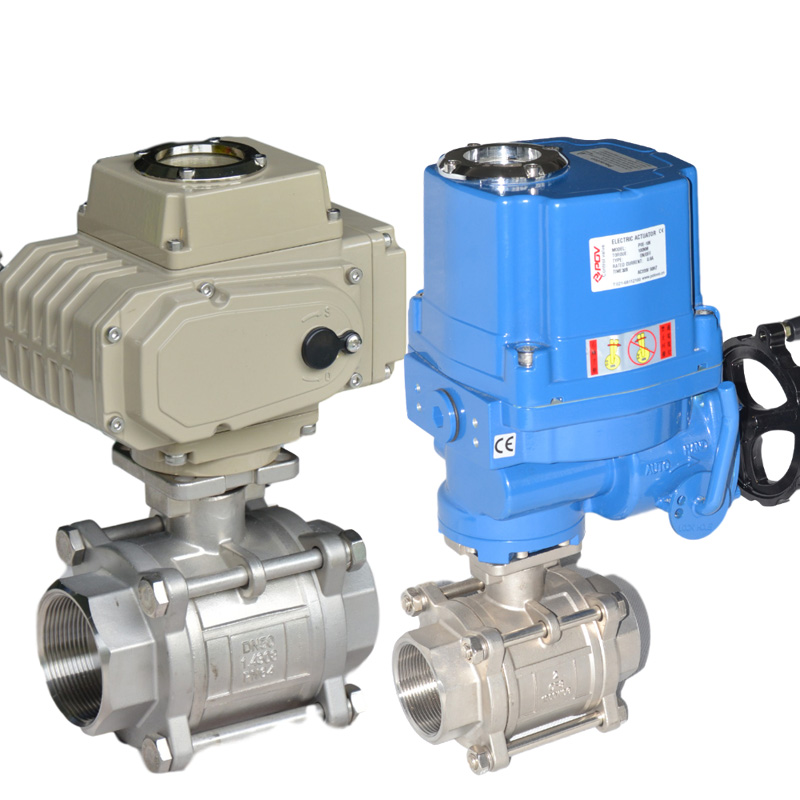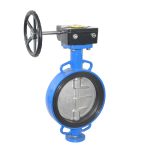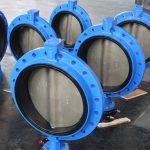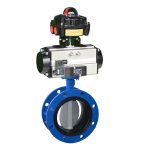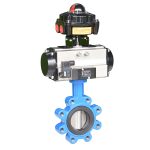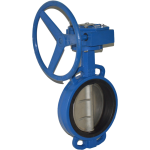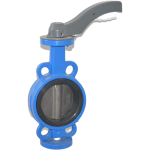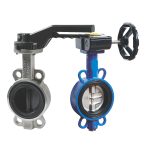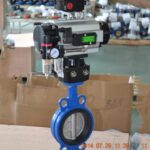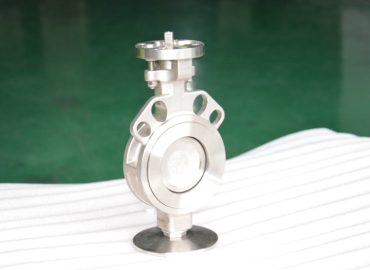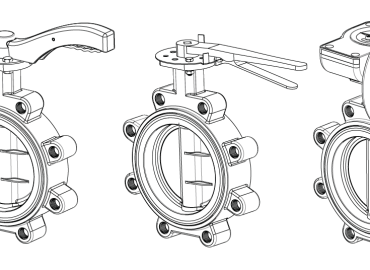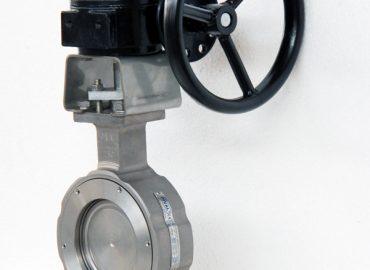Butterfly valves are used to regulate and control the flow of materials through pipes, tanks and other systems. Typically available in either manual or motorised models, they offer an efficient and cost-effective solution for a wide range of industrial applications. However, understanding the differences between these two types of butterfly valves is crucial for choosing the right valve for your specific application. In this blog post, we’ll explore how the operation of a motorised butterfly valve differs from that of a manual valve, examining the advantages and disadvantages of each as well as the key factors that influence selection.
What Is An Electric Butterfly Valve?
Experience the power of electric butterfly valves as they effortlessly cut off and regulate media. Curious about the inner workings of these remarkable devices? Satisfy your curiosity by watching our informative video that will unravel the working principle of electric actuator butterfly valves.
Introduction
The key difference between a motorized and manual butterfly valve is the method of operation. Manual butterfly valves are operated by turning a handle or a gear to open or close the valve. Manual operation is suitable for low-pressure applications that require infrequent adjustment or positioning. On the other hand, motorised butterfly valves are operated by an electric or pneumatic actuator that controls the valve position in response to a control signal from a computer or controller. Motorised operation provides precise control and can be automated for a wide range of applications including those requiring frequent adjustment or that are too large or too hazardous for manual operation. Additionally, motorized butterfly valve can be remotely operated and monitored, making them ideal for use in remote locations or hazardous environments.
Explanation of butterfly valves and their common uses
Butterfly valves are a type of quarter-turn valve that use a flat, disc-shaped element as the closing element to regulate the flow of fluid through a pipeline. The disc is mounted on a rod passing through the centre of the disc, and is operated by a lever or a gear that is turned a quarter turn to open or close the valve. Butterfly valves are commonly used in both commercial and industrial settings due to their simple design and ease of operation. They are ideal for applications where cost is a critical factor, yet low-pressure drop and tight shut-off are not critical components of the valve’s performance. Some common applications for butterfly valves include regulating flow in HVAC systems, controlling water treatment processes and handling food and beverage applications that require sanitary conditions.
Importance of understanding the differences in valve operation
Understanding the differences in valve operation is crucial because it ensures that the correct valve is selected for a specific application. Different operating environments, process applications and system parameters require different valve designs and control mechanisms. Choosing the wrong type of valve can result in decreased performance, increased maintenance costs or even catastrophic failure of the system. The choice between manual or motorized operation depends on the specific application requirements, such as the level of precision needed, the frequency of adjustments required, and more. Therefore, it is important to have a thorough understanding of valve operations so that the right valve is selected to ensure safe, efficient and reliable operation of the system.
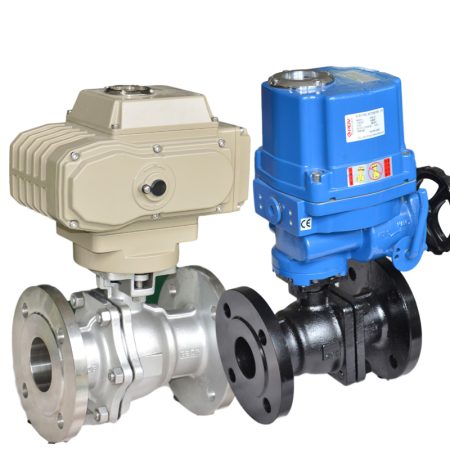
Manual Butterfly Valves
Manual butterfly valve are a popular choice for simple applications where the cost of the valve and its operation is a critical consideration. These valves are simple in design and consist of a circular disc, which is mounted on a rod, as the closing element. The disc is rotated by an external actuator, such as a handwheel or gear, to control the flow through the pipeline. Compared to other types of valves, butterfly valves have a shorter face-to-face dimension and require less installation space. They are also easy to install and maintain. However, manual butterfly valves are not suitable for applications requiring tight shut-off or precise control, as they have a high rate of leakage and the disc cannot be positioned with the same degree of accuracy as motorized valves. These valves are ideal for low-pressure applications that require infrequent operation or adjustment. Despite their limitations, manual butterfly valves remain a popular choice in various industries, including food and beverage, pharmaceutical, water treatment and HVAC, due to their low cost, simplicity and ease of operation.
Overview of manual butterfly valves and their construction
Manual butterfly valves are used to regulate the flow of fluids in pipelines and are typically constructed of a flat, circular disc, which is mounted on a rod or shaft. The disc is positioned at right angles to the flow of fluid and is supported by a central shaft. The disc is controlled by an external actuator, such as a handwheel or a gear, which rotates the disc anti-clockwise to open the valve and clockwise to close the valve. The actuator is connected directly to the central shaft, which controls the position of the disc. Additionally, manual butterfly valves are available in several different materials, including stainless steel, cast iron, and PVC, to suit different applications, environments and media. The materials used for construction depend on the specific application, such as the temperature, pressure, and the corrosive or abrasive nature of the fluid being transported. Maintenance of manual butterfly valves consists of periodic lubrication and tightening of the actuator connection.
Explanation of manual valve operation
Manual butterfly valve operation is initiated by rotating a handwheel or a gear that is connected to the central shaft controlling the position of the disc, thereby setting the flow rate of the fluid in the pipeline. The actuator can be locked in place, which keeps the valve in a certain position, or used for manual adjustment of the flow rate. The disc’s angle of rotation determines the degree of throttling, and the valve’s degree of opening, which directly affects the fluid’s flow rate. The valve’s position is indicated by the valve’s stem or shaft, which shows the valve orientation, whether it is opened or closed, and the degree of opening. This type of valve offers quick, simple and reliable operation, with easy access for maintenance, inspection and cleaning. However, manual butterfly valves do not provide precision control or remote operation, which can be a disadvantage in applications that require frequent adjustments, remote operation or tight shut-off.
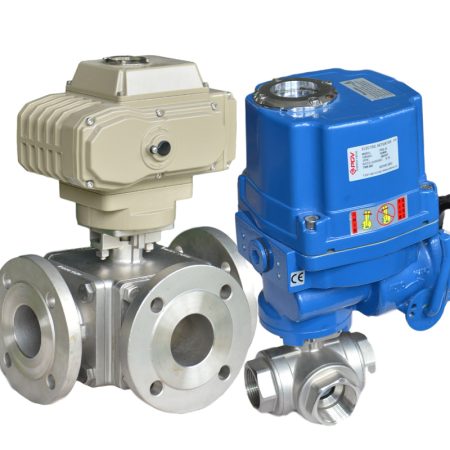
Advantages and disadvantages of manual butterfly valves
Manual butterfly valves offer several advantages, including their low cost, easy installation and low maintenance requirements. They are an ideal choice for simple applications where precise control is not required, and the system operates at low pressure. They are simple in design and have a smaller face-to-face dimension than other types of valves, require less space and are available in different materials to suit different applications. Additionally, manual butterfly valves are easy to operate, providing reliable flow control. However, these valves also have several limitations, including high leakage rates and a reduced degree of accuracy compared to motorised valves. The lack of precision control limits their application as they are unsuitable for applications requiring tight shut-off or precise control. Additionally, manual operation can be difficult in applications where frequent adjustments are needed, and the valve is located in remote or hazardous environments.
Motorised Butterfly Valves
Electric butterfly valve are a type of quarter-turn valve that use an electric or pneumatic actuator to control the valve’s position, thereby opening or closing the valve to regulate the flow of fluid through a pipeline. They are used in a wide range of applications where precise control and high levels of automation are required. Motorised butterfly valves can be operated remotely, and with the use of feedback sensors, they enable closed-loop control of the valve position for highly accurate flow control. They also have a lower leakage rate than manual butterfly valves, making them suitable for applications requiring tight shut-off, such as those in the petrochemical and pharmaceutical industries. Motorised butterfly valves are available in several materials that are suitable for different environments and applications. Electrically actuated valves are often preferred in locations where compressed air is unavailable, while pneumatic valves are preferred where flammable environments are a concern.
Furthermore, the use of intelligent control systems allows for predictive understanding of the system, resulting in better performance. The system will send alerts to operators for maintenance requirements and failures to ensure efficient operation. These features make motorised butterfly valves an ideal choice for a range of complex applications, such as chemical processing, oil and gas, water treatment and automotive manufacturing. However, despite their many advantages, motorised butterfly valves have a higher initial cost and greater complexity than manual butterfly valves. They also require more regular maintenance and periodic calibration to ensure optimum performance. Therefore, the selection of valve type depends on the specific application requirements, including space limitations, environmental conditions, usage scenarios and desired levels of accuracy, automation and cost.
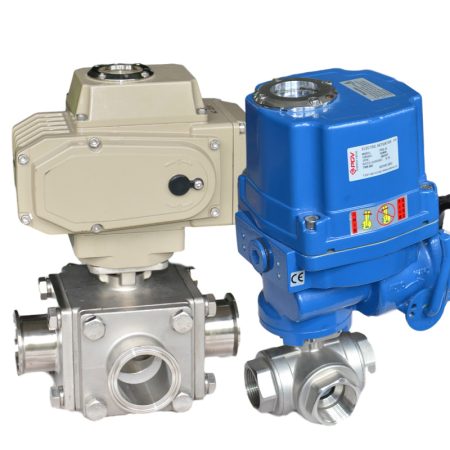
Overview of motorised butterfly valves and their construction
Motorised butterfly valves are similarly constructed to manual butterfly valves, with a flat circular disc on a central shaft used as the closing element. The main difference is the addition of an actuator unit that drives the valve’s rotation. The actuator is available in electric and pneumatic models, with electric valves being more common in most applications with larger sizes, higher torque outputs, and larger pressure ratings. The actuator control of the valve position allows for precise control of fluid flow in a pipeline. Motorised butterfly valves consist of several components, including the disc, actuator, and control mechanisms. The control mechanisms play a vital role in the valve operation, as they receive the input signal from a controller or computer, and then adjust the actuator to position the valve or open/close it. The control mechanisms use sensors to monitor the system and provide feedback to the controller to ensure that the valve operates correctly, without any faults or damages. Additionally, motorised butterfly valves are also available in different material constructions such as stainless steel, PVC or cast iron, and have a compact design to save installation space. Subsequently, motorised butterfly valves can be customised to meet specific application requirements, making them a flexible and versatile choice across a variety of industries.
Explanation of motorised valve operation
Motorised butterfly valves operate by using an actuator that drives the valve disc’s rotation. The actuator, which can be electric or pneumatic, receives a signal from a controller or computer indicating the desired valve position (open, closed or intermediate), and then adjusts the position of the actuator, thereby moving the valve disc. This precise operation allows for accurate control of the flow rate in the pipeline. Motorised butterfly valve operation can also be remotely controlled, which eliminates the need for personnel to physically turn the valve, making it ideal for applications where the valve is located in remote or dangerous locations. Additionally, the use of feedback sensors allows for closed-loop control, which ensures precise control of the valve position and flow rate, and reduces the risk of system failure due to incorrect valve positioning. Motorised valves may also include additional features such as adjustable speed control, torque and position control, advanced monitoring and diagnostics, and system integration, which significantly improve the overall efficiency and performance of the system. Thus, motorised butterfly valves provide excellent control, with enhanced performance and reliability over manual butterfly valves, making them a popular choice for complex and critical applications.
Advantages and disadvantages of motorised butterfly valves
Motor operated butterfly valve offer several advantages over manual butterfly valves, including precise control, enhanced reliability, and remote operation. The use of an actuator ensures accurate positioning of the valve disc, allowing for precise control of the flow rate in the pipeline. Feedback sensors and closed-loop control result in heightened system efficiency and reduced risk of system failure. Motorised valves are suitable for applications in challenging conditions or hazardous environments, and the option for remote control provides safer operation. Additionally, motorised butterfly valves are available in several materials, offering flexibility to suit different applications.
However, there are also some disadvantages to motorised butterfly valves, including higher initial costs, increased complexity, and a greater need for regular maintenance and calibration. The requirement for regular maintenance can cause increased downtime, reducing productivity. Moreover, motorised valves require additional support systems such as a power supply, controller and sensors, adding complexity and associated costs of installation and maintenance. Despite these disadvantages, motorised butterfly valves are an ideal choice for applications requiring precise control over fluid flow in a pipeline. The selection of valve type depends on the application’s specific requirements, including space, usage scenarios, environmental conditions, and desired levels of accuracy, automation and cost.
Differences in valve control, including electrical and pneumatic methods
The differences in valve control methods for electric actuated butterfly valve include electrical and pneumatic methods. Electrically actuated valves use an electric motor to drive the actuator, influencing the valve’s positioning based on feedback readings of the valve’s current position, torque and speed. These valves provide precise positioning control and can be used in a wide range of applications. They are also suitable for low power applications and remote monitoring. Pneumatic actuated valves, on the other hand, use compressed air or other gases to adjust the valve’s position. Pneumatic valves are reliable, long-lasting, and low-maintenance, making them suitable for use in remote or challenging environments. However, control of pneumatic valves requires more complex systems than electrical actuated valves. Valve control systems must provide a source of compressed air, an instrument air pressure regulator, filter, lubricator, and clean dry air supply. Monitoring and measurement systems are required to ensure maximum efficiency and safety within the system. Choosing the right control method depends on the application’s specific requirements, such as maximum operating pressure, the type of fluid flowing through the valve, energy efficiency, cost, control responses and other relevant factors.
Comparison of costs between manual and motorised butterfly valves
The two main types of butterfly valves are manual and motorised. Manual butterfly valves require no external power source and operate manually using a handle to open or close the disc. Motorised butterfly valves use an actuator, typically driven by an electric motor, to provide automated operation with precise control over the valve’s position.
The cost comparison between manual and motorised butterfly valves depends on several factors, such as size, application requirements, availability of materials and more. Generally speaking, manual butterfly valves tend to be lower in initial cost than motorized models due to their simplicity of installation and operation. However, they often require frequent maintenance due to wear and tear over time. By contrast, motorised butterfly valves usually have higher upfront costs but offer greater precision control and improved reliability in the long run with minimal maintenance required. Ultimately, depending on the specific application requirements, both options can be suitable for applications requiring tight regulation of flow rates or pressure within pipelines.
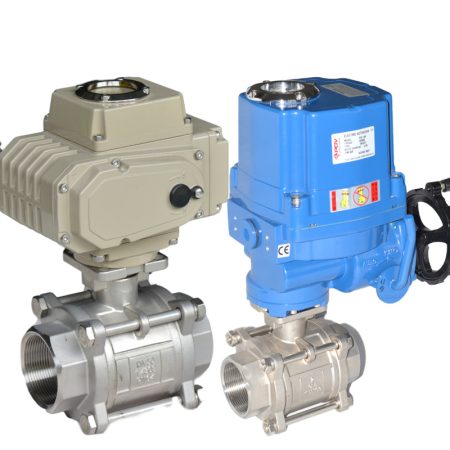
Conclusion
In conclusion, electric butterfly valve offer more precise control and automation over manual butterfly valves. Whereas manual valves require someone to manually operate the valve handle, motorised butterfly valves use an actuator driven by an electric motor to automate the operation. This offers greater control over the valve’s positioning at all times, reducing maintenance and operating costs in the long run. However, motorised butterfly valves tend to have higher upfront costs compared to manual ones, making it important to consider specific application requirements when selecting the right type of valve for your system. Ultimately, both options can be used depending on the application’s needs, though it is important to assess which type of valve best suits your situation before installing or making any final decisions.
Summary of key points
In summary, butterfly valves are used in various applications across different industries to control the flow, pressure and direction of media. Manual butterfly valves require no external power source but need regular maintenance, while motorised butterfly valves require a power source and provide more precise control but have higher upfront costs. Several factors should be taken into consideration when selecting the right type of valve for the system, such as size, application requirements and availability of materials. Ultimately, both manual and motorised butterfly valves can offer suitable solutions depending on what best meets your needs.
Importance of choosing the right type of valve for your application
Selecting the right type of butterfly valve for your application is crucially important. Not only does it guarantee that you get the most out of your system’s performance, but it also ensures that your investment is secure and protected in the long run. Actuated butterfly valve tend to be more expensive than manual ones, so it is essential to assess which type is best suited for your application’s needs before committing to one or the other. Additionally, it’s important to take into account factors such as size and weight (in case of manual valves) as well as availability of materials when selecting a valve. That way, you can make sure that you are investing in something that will provide good value over time.
Final thoughts on the benefits and drawbacks of both manual and motorised butterfly valves
Ultimately, manual and motorised butterfly valves can both offer items that are suitable for a variety of applications, depending on what the user needs. Manual butterfly valves require no external power source, are easier to install and maintain, and have lower upfront costs. However, they have limited accuracy as compared to motorised butterfly valve. On the other hand, motorised butterfly valve require an external power source and have higher upfront costs but offer superior control due to their more precise operation. In conclusion, both types of valves can bring value in different ways for various systems — it is up to the user to determine which type is best suited for their specific application.


